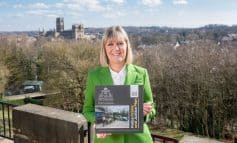Councillors at Durham County Council are to hear a new action plan to address a decline in biodiversity.
The local authority’s cabinet will be presented with a plan to address an ecological emergency which was declared by the authority in April.
The Ecological Emergency Action Plan (EEAP) focuses on three key areas where changes are proposed to reverse a decline in biodiversity in County Durham.
Cllr Mark Wilkes, Durham County Council’s Cabinet member for neighbourhoods and climate change, said: “Biodiversity is key to having a thriving natural environment. When it goes into decline, which is what we are currently seeing on a national scale, we start to lose important species that play a vital role in the natural world and which in turn influence the decline of other species.
“County Durham has a rich variety of habitats, from its upland peatland and moorland and seminatural ancient woodland to meadows and wetlands, and the species-rich Heritage Coast. This represents not only a valuable resource for biodiversity and a store for carbon, but an incredible asset for recreation and wellbeing.
“Working with partners, we have carried out considerable work to preserve these habitats as part of our Climate Emergency Response Plan.
“The Ecological Emergency Action Plan will provide further support, allowing us to give special focus to supporting biodiversity as part of our wider ambitions to tackle climate change.”
The EEAP outlines land management as a key area for addressing the issue, with the council planning to use its own land to make improvements that will support wildlife and plant species to thrive.
This includes environmental condition surveys carried out at the council’s nature reserves to seek ways to improve the management of these areas, and an ongoing programme to improve the council’s woodland estate through the Durham Woodland Revival and Great North Forest schemes.
The council is also directly involved with organisations such as SeaScapes, the North Pennines Area of Outstanding Natural Beauty (AONB), Land of Oak and Iron and Durham Heritage Coast partnerships, working to improve and preserve the county’s landscapes.
Another key part of the EEAP is education, where the council will seek to tackle the ecological emergency by highlighting the issue with the county’s residents and visitors.
This includes its already ongoing education programmes within the community, including its Trees for Children scheme and environmental education activities that take place across the council’s parks.
There are also plans for signs to be installed across council land to raise community awareness of the issues of biodiversity and how wildlife species are being supported in these areas – such as no-cutting zones.
The EEAP also aims to ensure biodiversity is built into future policies and strategies as a guiding factor for procurement and land management.
It will be integrated into a wider Local Nature Recovery Strategy for County Durham, as well as future Climate Change Emergency Response Plans.
If approved by Cabinet, actions will commence to deliver the plan’s objectives, with progress updates to be given in 12 months’ time.
Cabinet will hear more details when it meets on Wednesday, December 14, at 9.30am. Members of the public can attend in person or view the meeting live via the council’s
Pictured above (left to right): Cllr Mark Wilkes, Durham County Council’s cabinet member for neighbourhoods and climate change, Alistair Lockett, AONB field officer, and Paul Leadbitter, AONB peatland programme manager.








